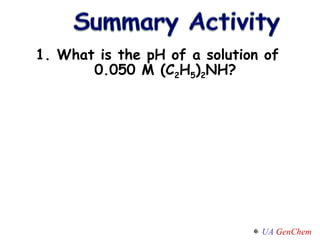
Lect w8 152 - ka and kb calculations_summary exercises_alg
- 1. 1. What is the pH of a solution of 0.050 M (C 2 H 5 ) 2 NH?
- 2. 2. What is the pH of a solution of 0.050 M HClO 4 ?
- 3. Summary Activity 3. Label the following as acidic, basic, or neutral solutions: KCl NaNO 2 (CH 3 ) 2 NH 2 Cl
- 4. Which of the following is the strongest acid? HClO 2 , HBrO 2 , HIO 2
- 5. Which of the following is the strongest acid? H 3 N, H 2 O, HF
- 7. 1. What is the pH of a solution of 0.050 M (C 2 H 5 ) 2 NH? (K b = 4.9 10 -4 ) The approximation is invalid! 0.05/(4.9 10 -4 ) = 72 ICE Table (C 2 H 5 ) 2 NH + H 2 O (C 2 H 5 ) 2 NH 2 + + OH - I 0.050 0 0 C -x +x +x E 0.050-x x x K b = [(C 2 H 5 ) 2 NH 2 + ][OH - ] = x 2 (C 2 H 5 ) 2 NH 0.050-x quadratic x 2 + (4.9 10 -4 )x – (2.45 10 -5 ) = 0 x = 4.7 10 -3 = [OH - ] pOH = -log(4.7 10 -3 ) = 2.33 pH = 14 – 2.33 = 11.67
- 8. 2. What is the pH of a solution of 0.050 M HClO 4 ? Easy!! HClO 4 is a strong acid, therefore [HClO 4 ] = [H 3 O + ] dissociated! [H 3 O + ] = 0.050 M pH = -log(0.050) pH = 1.30
- 9. Summary Activity 3. Label the following as acidic, basic, or neutral solutions: KCl NaNO 2 (CH 3 ) 2 NH 2 Cl neutral basic acidic K + (cation of a strong base) neutral Cl - (anion of a strong acid) neutral Overall neutral
- 10. Summary Activity 3. Label the following as acidic, basic, or neutral solutions: KCl NaNO 2 (CH 3 ) 2 NH 2 Cl neutral basic acidic Na + (cation of a strong base) neutral NO 2 - (anion of a weak acid ) basic Overall basic
- 11. Summary Activity 3. Label the following as acidic, basic, or neutral solutions: KCl NaNO 2 (CH 3 ) 2 NH 2 Cl neutral basic acidic (CH 3 ) 2 NH 2 + (cation of a weak base —4 groups attached to N) acidic Cl - (anion of a strong acid) neutral Overall acidic
- 12. Which of the following is the strongest acid? HClO 2 , HBrO 2 , HIO 2 Non-binary acids must consider resonance or inductive effect not resonance 1) there are no possible resonance structures (already saturated) 2) all Lewis dot structures are equivalent inductive effect ClO 2 - has Cl (which is more electronegative than Br or I). The Cl withdraws the electrons from the O atoms, stabilizing the anion making the HClO 2 more acidic O—Cl—O : : : : : : : : O—Br—O : : : : : : : : O—I—O : : : : : : : :
- 13. Which of the following is the strongest acid? H 3 N, H 2 O, HF Binary acids must consider electronegativity or size of the anion N O F moving left to right across periodic chart Therefore HF is strongest acid because its anion is the most electronegative atom in the group above. And the more electronegative the anion, the greater the ability to stabilize the anion, and therefore the stronger the acid
Notes de l'éditeur
- Kb = 6.9e-4
- Kb = 6.9e-4